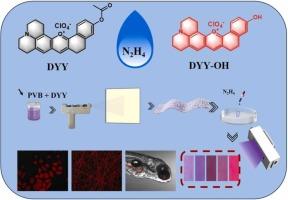Development of red fluorescent probe for visual detection of N2H4 via nanofiber membrane and its application in environmental analysis and biological imaging
IF 8
1区 化学
Q1 CHEMISTRY, ANALYTICAL
引用次数: 0
Abstract
Hydrazine (N2H4) is widely used in most industrial production. It is a harmful environmental pollutant and has strong toxicity to living organisms. Hence, it is imperative to employ approach for the real-time monitoring and tracking of N2H4. In this study, we developed the fluorescent probe DYY, incorporating an acetyl group as the recognition moiety, to achieve efficient detection of N2H4. The findings revealed that DYY exhibits excellent sensitivity (with a detection limit of 81 nM) and a wide pH range (2-8) in the detection of N2H4. Notably, upon the addition of N2H4, the color of the DYY solution transitioned from purple to blue, accompanied the fluorescence intensity increased by 11-fold increase in 643 nm. In addition, DYY demonstrated its capability in detecting N2H4 contamination within environmental water samples. Significantly, polymer nanofibers embedded with DYY were fabricated through the process of electrospinning, allowing for the visual identification of N2H4. Furthermore, it showed excellent performance in detecting N2H4 in HepG2 cells and zebrafish, demonstrating its potential for labeling N2H4 in living systems. Therefore, we are confident that this probe holds significant potential for environmental analysis and the detection of health indicators in living organisms.

纳米纤维膜视觉检测 N2H4 的红色荧光探针的开发及其在环境分析和生物成像中的应用
肼(N2H4)广泛用于大多数工业生产。它是一种有害的环境污染物,对生物体有很强的毒性。因此,采用实时监测和跟踪 N2H4 的方法势在必行。本研究开发了以乙酰基为识别分子的荧光探针 DYY,以实现对 N2H4 的高效检测。研究结果表明,DYY 在检测 N2H4 时具有出色的灵敏度(检测限为 81 nM)和较宽的 pH 值范围(2-8)。值得注意的是,加入 N2H4 后,DYY 溶液的颜色由紫色转变为蓝色,同时在 643 纳米波长处的荧光强度增加了 11 倍。此外,DYY 还证明了其检测环境水样中 N2H4 污染的能力。值得注意的是,通过电纺丝工艺制造出了嵌入 DYY 的聚合物纳米纤维,从而实现了对 N2H4 的视觉识别。此外,该探针在检测 HepG2 细胞和斑马鱼体内的 N2H4 方面表现出色,证明了其在生物系统中标记 N2H4 的潜力。因此,我们相信该探针在环境分析和生物体内健康指标检测方面具有巨大潜力。
本文章由计算机程序翻译,如有差异,请以英文原文为准。
求助全文
约1分钟内获得全文
求助全文
来源期刊

Sensors and Actuators B: Chemical
工程技术-电化学
CiteScore
14.60
自引率
11.90%
发文量
1776
审稿时长
3.2 months
期刊介绍:
Sensors & Actuators, B: Chemical is an international journal focused on the research and development of chemical transducers. It covers chemical sensors and biosensors, chemical actuators, and analytical microsystems. The journal is interdisciplinary, aiming to publish original works showcasing substantial advancements beyond the current state of the art in these fields, with practical applicability to solving meaningful analytical problems. Review articles are accepted by invitation from an Editor of the journal.
 求助内容:
求助内容: 应助结果提醒方式:
应助结果提醒方式:


